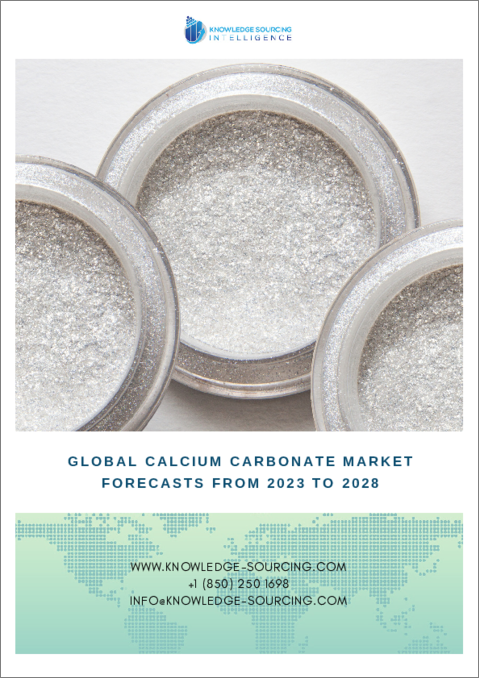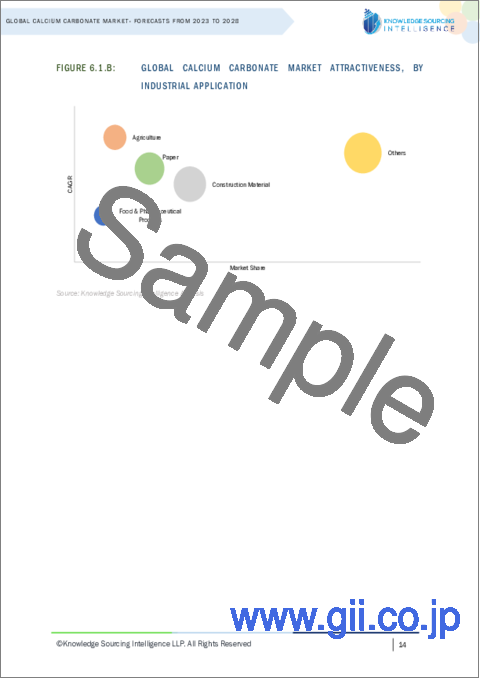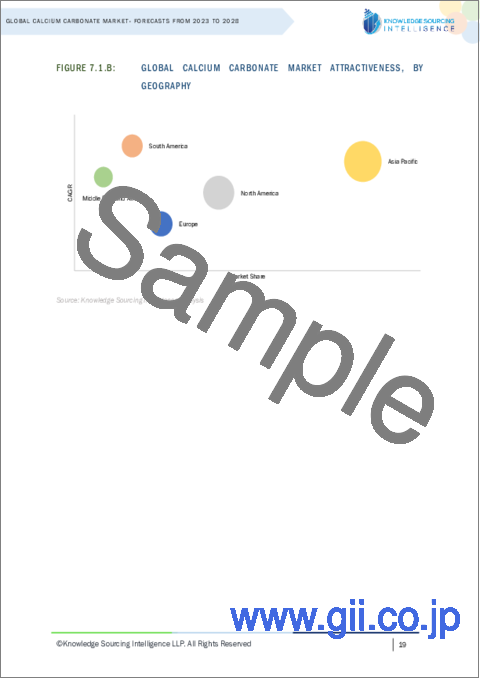|
|
市場調査レポート
商品コード
1295357
炭酸カルシウムの世界市場-2023年から2028年までの予測Global Calcium Carbonate Market - Forecasts from 2023 to 2028 |
||||||
カスタマイズ可能
|
|||||||
| 炭酸カルシウムの世界市場-2023年から2028年までの予測 |
|
出版日: 2023年06月07日
発行: Knowledge Sourcing Intelligence
ページ情報: 英文 158 Pages
納期: 即日から翌営業日
|
- 全表示
- 概要
- 目次
炭酸カルシウム市場は複合年間成長率4.26%を記録し、2021年の34億6,100万米ドルから2028年には46億3,400万米ドルに成長すると予測されています。包装用途やティッシュペーパーのような衛生関連製品からの紙の需要の増加は、市場の主要な成長促進要因です。
製紙業界からの需要の増加は、炭酸カルシウム市場の主要な促進要因です。
炭酸カルシウムは、製紙工場でアルカリ抄紙の充填材として広く使用されています。より明るく嵩高な紙への需要の高まりが、製紙業界における炭酸カルシウムの主要な促進要因です。製紙業界では、高い明度と光散乱特性により世界的に評価されており、明るい不透明紙を作るための安価な填料として使用されています。さらに、中国、インド、カナダ、米国、欧州連合(EU)のような国が使い捨てプラスチック包装製品を禁止しているため、食料品店、食品配達システム、衣料品店などの包装ソリューション用の紙の需要が高まっており、紙のエンドユーザー産業における炭酸カルシウムの需要にプラスの影響を与えています。
また、炭酸カルシウムは塗料やその他の建築資材を生産するために不可欠な原料であるため、住宅・住宅分野での継続的な支出も市場の成長を促進すると予想されます。米国商務省国勢調査局によると、米国の建設支出の約50%は住宅部門から生み出されています。2023年2月には、1兆8,000億米ドルが建設に費やされ、そのうち8,520億米ドルが住宅・居住部門に費やされました。したがって、世界中で建設業界が飛躍的な成長を遂げ、紙とプラスチックの需要が増加していることから、炭酸カルシウムの需要は予測期間中に大きく伸びると予測されます。
食品・医薬品業界では、炭酸カルシウムの需要が増加しています。
炭酸カルシウムは医薬品業界では一般的な添加物です。炭酸カルシウムは、有効成分として、また食事中のカルシウム量が不足している場合の栄養補助食品として使用されます。クリーブランド・クリニックは、成人の1日のカルシウム必要量は1,000~1,200ミリグラムに収まるとしています。一方、炭酸カルシウムのサプリメントは、1錠あたり500~600ミリグラムのカルシウムを摂取できます。
さらに、炭酸カルシウムはさまざまな化粧品やパーソナルケア製品の充填剤や緩衝剤として使用されるため、化粧品やパーソナルケア製品の需要拡大も炭酸カルシウムの需要を牽引すると予想されます。近年、天然素材やオーガニックのパーソナルケア製品に対する需要が高まっており、この分野での炭酸カルシウムの使用が増加しています。例えば、2020年にはフランスの化粧品会社であるロレアルが、炭酸カルシウムを主要成分として配合した新しいスキンケア製品シリーズを発売しました。その結果、こうした新製品の発売は市場の拡大につながると思われます。
塗料・コーティング、接着剤・シーリング剤、製紙は、北米の炭酸カルシウム市場を押し上げる主要セクターです。
北米の炭酸カルシウム市場は米国、カナダ、メキシコに区分されます。米国市場は、製紙・パルプ産業における炭酸カルシウムの需要増加、セメントやコンクリートなどの用途における建設分野での使用増加、充填剤や顔料としての特性によるプラスチック、塗料、コーティングなどの産業における炭酸カルシウムの利用拡大により成長が見込まれています。さらに、医療や製薬産業での炭酸カルシウムの採用が増加していることも、米国での市場成長に寄与しています。米国は世界有数の製紙メーカーであるため、予測期間中は紙が大きな市場シェアを占めると予想されます。米国森林製紙協会によると、米国の製紙・木材製品産業は2020年2月と3月に高水準のティッシュ生産を記録しました。
アジア太平洋の炭酸カルシウム市場は、包装、自動車、建設、電気・電子、その他の産業における様々な用途でのプラスチック使用の増加により、予測期間中に大きな成長が見込まれます。包装や建設産業におけるコスト削減、自動車部品の軽量化、電子製品の断熱包装など、多目的にプラスチックが使用されるようになっていることが、同地域の炭酸カルシウム需要を牽引しています。
市場動向:
- 2020年3月、世界的に有名なミネラル原料メーカーであるOmya社は、すぐに使える乳児用飲料や、より小さな子供向けのビスケットやシリアルを含む粉末乳児用製品を強化するために、非常に細かい粒子の特性を持つ天然カルシウム源を開発したと報告しました。Omya Calcipurは、95-KPと115-KPの2種類の天然炭酸カルシウム粒子を提供する製品です。
- 2020年3月、アングロ・パシフィック・グループPLCは、ドミニカ共和国における炭酸カルシウム鉱山と関連インフラの建設資金を調達するため、インコア・パフォーマンス・ミネラルズLLCと融資契約を締結したと発表しました。
目次
第1章 イントロダクション
- 市場概要
- 市場の定義
- 調査範囲
- 市場セグメンテーション
- 通貨
- 前提条件
- 基準年と予測年のタイムライン
第2章 調査手法
- 調査データ
- 調査プロセス
第3章 エグゼクティブサマリー
- 調査ハイライト
第4章 市場力学
- 市場促進要因
- 市場抑制要因
- ポーターのファイブフォース分析
- 業界バリューチェーン分析
第5章 炭酸カルシウムの世界市場:商業グレード別
- イントロダクション
- 沈降炭酸カルシウム(PCC)
- 天然炭酸カルシウム(GCC)
第6章 炭酸カルシウムの世界市場:業界別
- イントロダクション
- 建設
- 農業
- 製紙
- 飲食品
- 医薬品
- その他
第7章 炭酸カルシウムの世界市場:地域別
- イントロダクション
- 北米
- 商業グレード別
- 業界別
- 国別
- 南米
- 商業グレード別
- 業界別
- 国別
- 欧州
- 商業グレード別
- 業界別
- 国別
- 中東・アフリカ
- 商業グレード別
- 業界別
- 国別
- アジア太平洋
- 商業グレード別
- 業界別
- 国別
第8章 競合環境と分析
- 主要企業と戦略分析
- 新興企業と市場収益性
- 合併、買収、合意およびコラボレーション
- ベンダー競争力マトリックス
第9章 企業プロファイル
- Imerys
- Omya AG
- Minerals Technologies Inc.
- Huber Engineered Materials(part of J.M. Huber Corporation)
- Carmeuse Coordination Center SA
- Sibelco
- Excalibar Minerals(Newpark Resources Inc.)
- Calcinor
- Maruo Calcium Co., Ltd.
- Mississippi Lime Company
- Solvay
- Chu Shin Chemical Corporation Limited
- Lime Chemicals Ltd.
- ACCM
- Mewar Microns
The calcium carbonate market is projected to witness a compound annual growth rate of 4.26%, growing to US$4.634 billion by 2028 from US$3.461 billion in 2021.Calcium carbonate has a variety of applications, including toothpaste, paint, and cement. Increasing demand for paper from packaging applications and hygiene-related products such as tissue paper is a major growth driver for the market.
Increasing demand from the paper industry is a key driver of the calcium carbonate market.
Calcium carbonate is widely used in the paper mill as a filler material in alkaline papermaking. Growing demand for brighter and bulkier paper is the key driver for calcium carbonate in the paper industry. In the paper industry, it is valued worldwide for its high brightness and light scattering characteristics, and it is used as an inexpensive filler to make bright opaque paper. Additionally, countries like China, India, Canada, the United States, and European Union nations banning single-use plastic packaging products is driving the demand for paper for packaging solutions in grocery stores, food delivery systems, clothing stores, and others, thus, positively impacting the demand of calcium carbonate in paper end-user industry.
The continuous spending in the housing and residential sector is also expected to drive market growth as calcium carbonate is an essential raw material for producing paints and other construction materials. According to the U.S. Department of Commerce's Census Bureau, around 50% of construction spending in the United States is generated from the housing sector. In February 2023, US$1.8 trillion was spent on construction, of which US$852 billion was spent in the housing and residential sector. Therefore, with an increase in the demand for paper and plastics around the world as well as exponential growth being experienced by the construction industry, the demand for calcium carbonate is estimated to grow significantly during the forecast period.
The food and pharmaceutical products industry is witnessing an upswing in the demand for calcium carbonate.
Calcium carbonate is a common additive in the industry of pharmaceuticals. It is used as an active ingredient and as a dietary supplement when the amount of calcium in a diet is insufficient. The Cleveland Clinic suggests that an adult's daily calcium requirement falls within 1,000 to 1,200 milligrams. Calcium carbonate supplements, on the other hand, can deliver 500 to 600 milligrams of calcium per tablet.
Moreover, the growing demand for cosmetics and personal care products is also expected to drive the calcium carbonate demand as it is used as a filler and buffering agent in various cosmetics and personal care products. In recent years, there has been a growing demand for natural and organic personal care products, which has led to an increase in the use of calcium carbonate in this segment. For instance, in 2020, L'Oreal, a French cosmetics company, launched a new skincare product range that contains calcium carbonate as a key ingredient. As a result, these new product launches will result in market expansion.
Paints & coatings, adhesives & sealants, and paper manufacturing are key sectors boosting the North American calcium carbonate market.
The North American calcium carbonate market has been segmented into the United States, Canada, and Mexico. The USA market is expected to grow due to growing demand for calcium carbonate in the paper and pulp industry, increasing use in the construction sector for applications like cement and concrete, and the expanding utilization of calcium carbonate in industries like plastics, paints, and coatings due to its properties as a filler and pigment. Additionally, the rising adoption of calcium carbonate in the healthcare and pharmaceutical industries further contributes to its market growth in the USA. Paper is expected to account for a major market share during the forecast period as the U.S. is amongst the world's prominent paper manufacturers. According to the American Forest & Paper Association, the U.S. paper and wood products industry recorded high levels of tissue production in February and March of 2020.
The Asia Pacific calcium carbonate market is expected to witness significant growth over the forecast period owing to the increasing use of plastics for various applications in packaging, automotive, construction, electrical & electronics, and other industries. The growing use of plastics in these industries for multiple purposes, such as decreasing costs in packaging and construction industries, reducing weight in automotive parts, and as an insulator in electronic products, is driving the demand for calcium carbonate in the region.
Market Developments:
- In March 2020, Omya, which is a globally renowned producer of mineral ingredients, reported that it had developed a natural source of calcium with properties of very fine particles to enhance powdered infant products comprising ready-to-use infant drinks, as well as biscuits and cereals intended for smaller children. Omya Calcipur is a product that offers two types of natural calcium carbonate particles, namely 95-KP and 115-KP.
- In March 2020, Anglo Pacific Group PLC announced entering into a financing agreement with Incoa Performance Minerals LLC to fund the construction of a calcium carbonate mine and associated infrastructure in the Dominican Republic.
Market Segmentation:
By Commercial Grade
- Precipitated Calcium Carbonate (PCC)
- Ground Calcium Carbonate (GCC)
By Industry
- Construction
- Agriculture
- Paper
- Food & Beverage
- Pharmaceutical
- Others
By Geography
- North America
- USA
- Canada
- Mexico
- South America
- Brazil
- Argentina
- Others
- Europe
- UK
- Germany
- France
- Spain
- Others
- Middle East and Africa
- UAE
- Israel
- Saudi Arabia
- Others
- Asia Pacific
- Japan
- China
- India
- South Korea
- Indonesia
- Thailand
- Australia
- Others
TABLE OF CONTENTS
1. INTRODUCTION
- 1.1. Market Overview
- 1.2. Market Definition
- 1.3. Scope of the Study
- 1.4. Market Segmentation
- 1.5. Currency
- 1.6. Assumptions
- 1.7. Base, and Forecast Years Timeline
2. RESEARCH METHODOLOGY
- 2.1. Research Data
- 2.2. Research Process
3. EXECUTIVE SUMMARY
- 3.1. Research Highlights
4. MARKET DYNAMICS
- 4.1. Market Drivers
- 4.2. Market Restraints
- 4.3. Porter's Five Force Analysis
- 4.3.1. Bargaining Power of Suppliers
- 4.3.2. Bargaining Power of Buyers
- 4.3.3. Threat of New Entrants
- 4.3.4. Threat of Substitutes
- 4.3.5. Competitive Rivalry in the Industry
- 4.4. Industry Value Chain Analysis
5. GLOBAL CALCIUM CARBONATE MARKET BY COMMERCIAL GRADE
- 5.1. Introduction
- 5.2. Precipitated Calcium Carbonate (PCC)
- 5.3. Ground Calcium Carbonate (GCC)
6. GLOBAL CALCIUM CARBONATE MARKET BY INDUSTRY
- 6.1. Introduction
- 6.2. Construction
- 6.3. Agriculture
- 6.4. Paper
- 6.5. Food & Beverage
- 6.6. Pharmaceutical
- 6.7. Others
7. GLOBAL CALCIUM CARBONATE MARKET BY GEOGRAPHY
- 7.1. Introduction
- 7.2. North America
- 7.2.1. By Commercial Grade
- 7.2.2. By Industry
- 7.2.3. By Country
- 7.2.3.1. United States
- 7.2.3.2. Canada
- 7.2.3.3. Mexico
- 7.3. South America
- 7.3.1. By Commercial Grade
- 7.3.2. By Industry
- 7.3.3. By Country
- 7.3.3.1. Brazil
- 7.3.3.2. Argentina
- 7.3.3.3. Others
- 7.4. Europe
- 7.4.1. By Commercial Grade
- 7.4.2. By Industry
- 7.4.3. By Country
- 7.4.3.1. United Kingdom
- 7.4.3.2. Germany
- 7.4.3.3. France
- 7.4.3.4. Spain
- 7.4.3.5. Others
- 7.5. Middle East and Africa
- 7.5.1. By Commercial Grade
- 7.5.2. By Industry
- 7.5.3. By Country
- 7.5.3.1. UAE
- 7.5.3.2. Israel
- 7.5.3.3. Saudi Arabia
- 7.5.3.4. Others
- 7.6. Asia Pacific
- 7.6.1. By Commercial Grade
- 7.6.2. By Industry
- 7.6.3. By Country
- 7.6.3.1. Japan
- 7.6.3.2. China
- 7.6.3.3. India
- 7.6.3.4. South Korea
- 7.6.3.5. Indonesia
- 7.6.3.6. Thailand
- 7.6.3.7. Australia
- 7.6.3.8. Others
8. COMPETITIVE ENVIRONMENT AND ANALYSIS
- 8.1. Major Players and Strategy Analysis
- 8.2. Emerging Players and Market Lucrativeness
- 8.3. Mergers, Acquisitions, Agreements, and Collaborations
- 8.4. Vendor Competitiveness Matrix
9. COMPANY PROFILES
- 9.1. Imerys
- 9.2. Omya AG
- 9.3. Minerals Technologies Inc.
- 9.4. Huber Engineered Materials (part of J.M. Huber Corporation)
- 9.5. Carmeuse Coordination Center SA
- 9.6. Sibelco
- 9.7. Excalibar Minerals (Newpark Resources Inc.)
- 9.8. Calcinor
- 9.9. Maruo Calcium Co., Ltd.
- 9.10. Mississippi Lime Company
- 9.11. Solvay
- 9.12. Chu Shin Chemical Corporation Limited
- 9.13. Lime Chemicals Ltd.
- 9.14. ACCM
- 9.15. Mewar Microns






